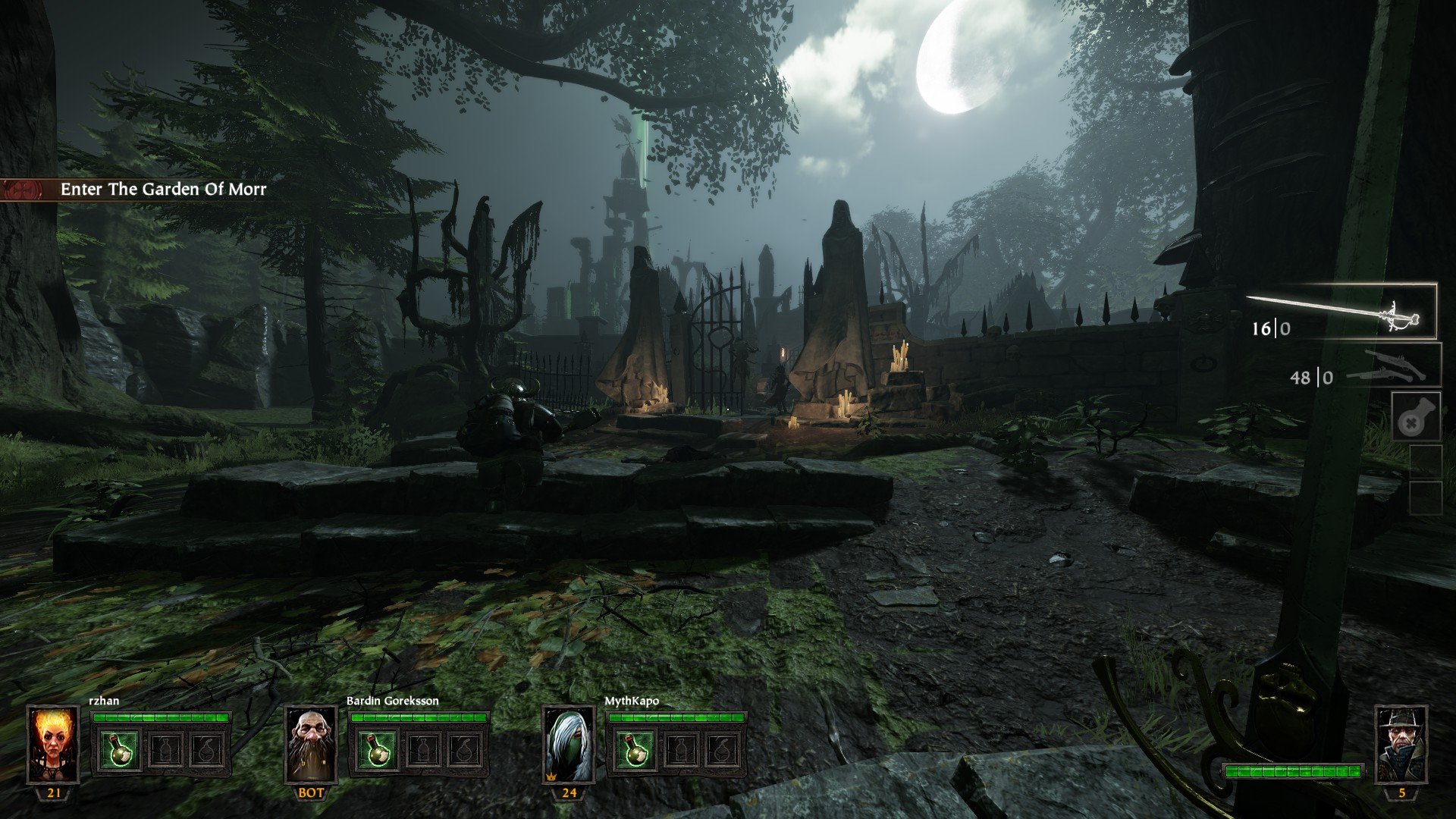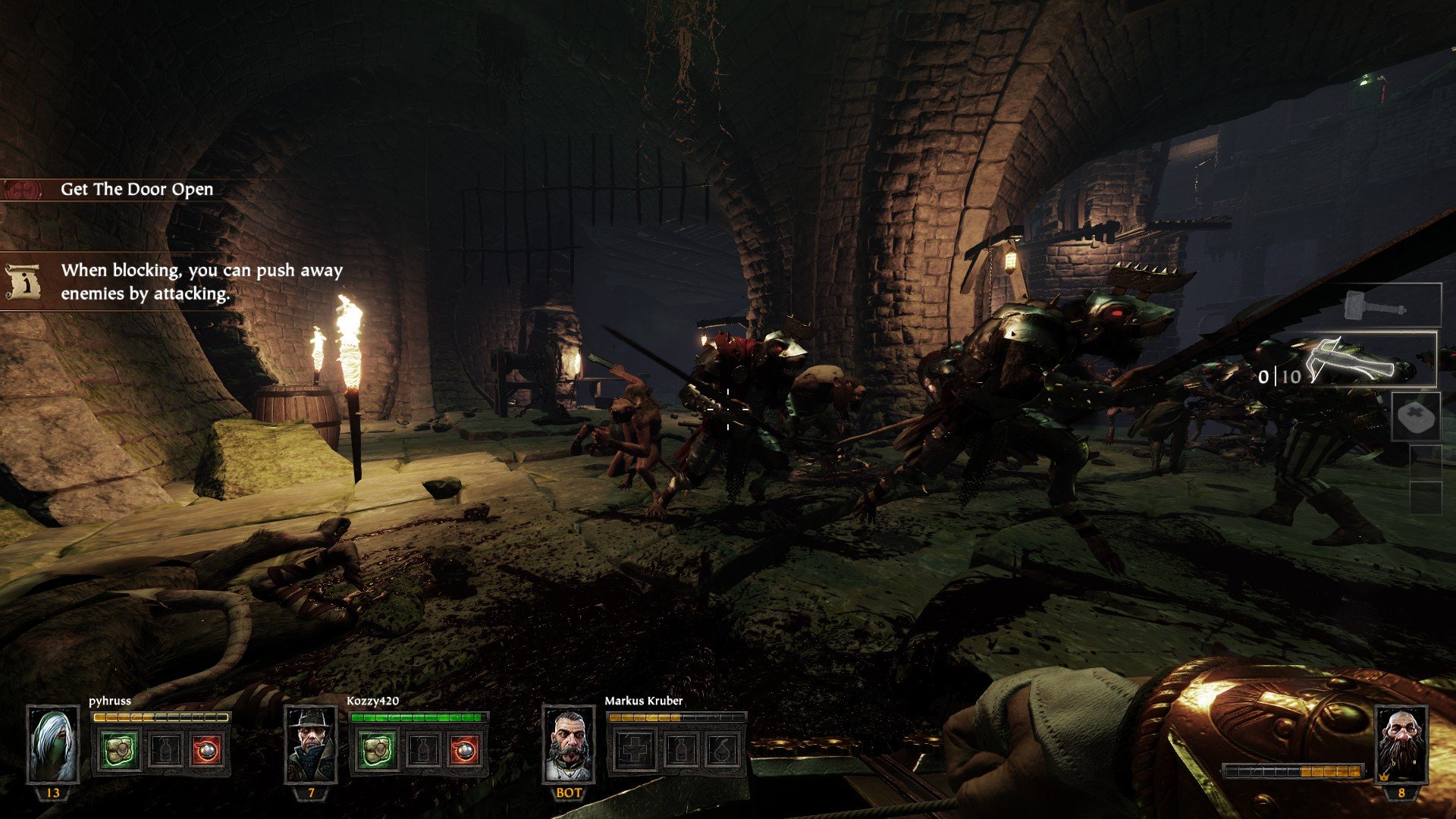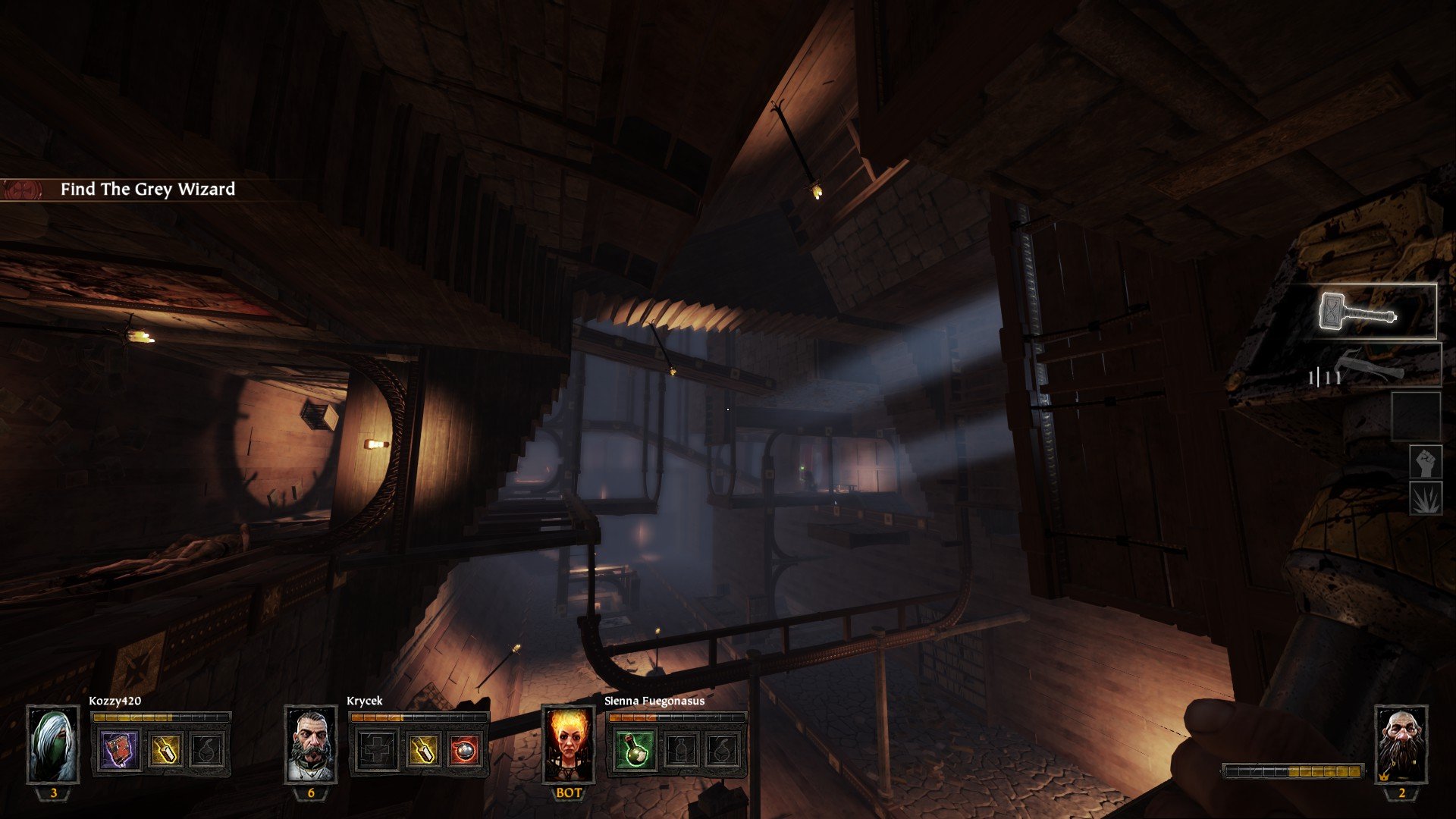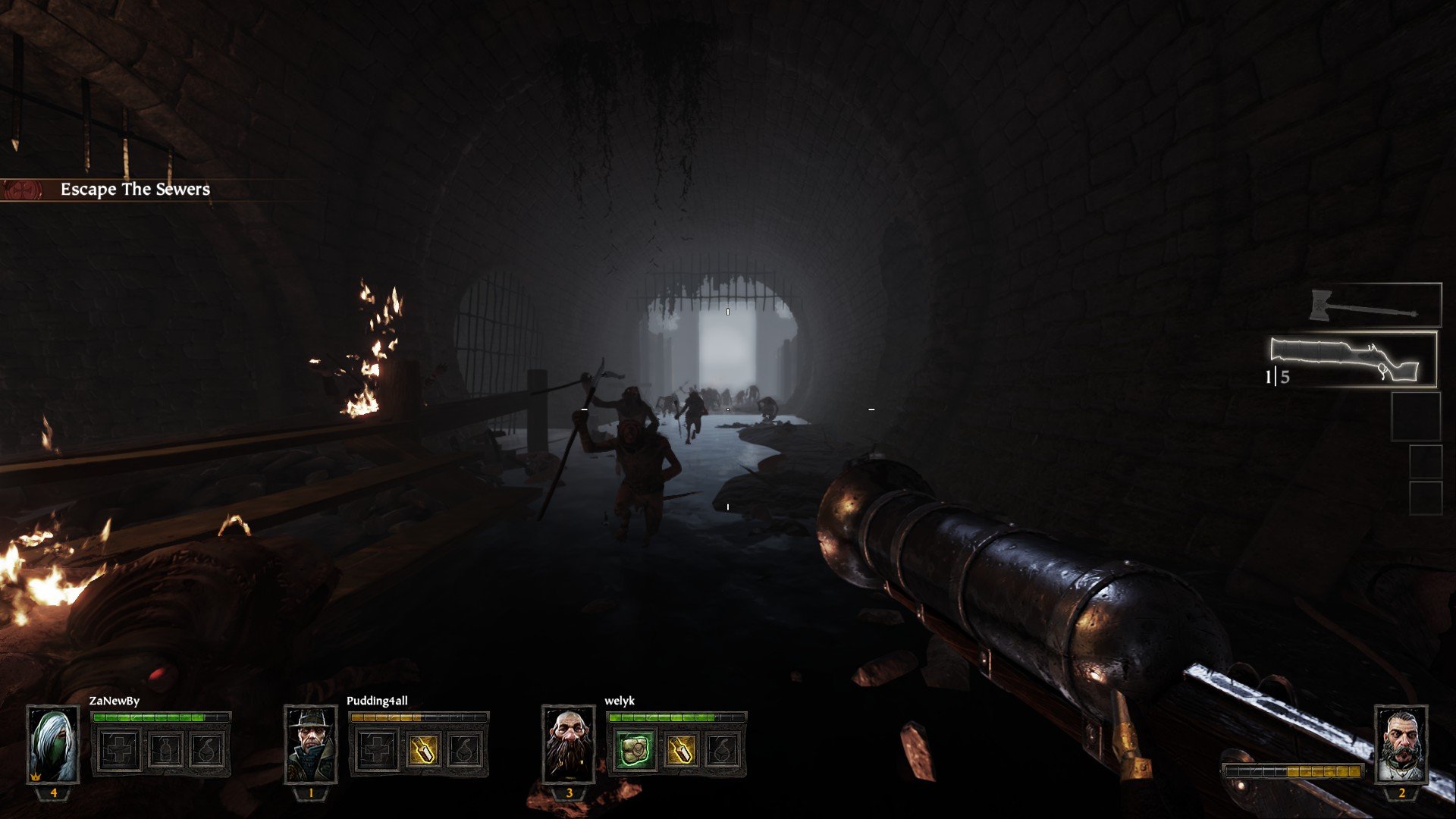Warhammer: End Times – Vermintide Review
Warhammer: The End Times – Vermintide is a four player first-person co-op game that borrows heavily from the Left 4 Dead series. I make the comparison early because the similarities are obvious and abundant. Fat Shark have taken Valve/Turtle Rock’s design for the popular zombie-killing franchise and transplanted it into the Warhammer universe, borrowing level design and objective ideas, pacing, UI elements, enemy types and the mechanic of the ‘AI director’ who changes enemy and item placements and types when replaying levels. Even the way the camera pans around at the start of each level before zooming in behind the players is done in exactly the same way as Left 4 Dead. However despite the myriad similarities, there are a few crucial differences that set it apart enough that is shouldn’t necessarily be labeled as a lazy rip-off.

The biggest thing differentiating Vermintide from that other series is the clear emphasis on melee combat. Your primary weapon will be a sword, hammer, axe, mace or some other object designed to cut, bludgeon, or crush your furry opponents. The melee focus isn’t surprising given the developer’s background with War of the Roses and War of the Vikings, and the combat system in Vermintide is a good one, though not perfect. You have fast attacks, heavy attacks, and in some cases special attacks with your melee weapons. You can also block, and push enemies back while blocking, but a limited stamina meter means you can only block so many blows before your guard is broken.
Just as L4D2 let you use melee weapons as a backup, Vermintide provides each player with a ranged weapon as an alternative. The ranged weapons are surprisingly entertaining to use, varying from crossbows and bows to old-school pistols, shotguns and rifles with a great variety of ranges, damage levels and uses. The mixture of melee and ranged combat is at the core of Vermintide, and the good sense of weight that weapons have make for a satisfying experience.
While the combat model is a good one, it is not perfect. Vermintide is a Warhammer game, and the enemy you are fighting are the Scaven, a race of rat-men who are taking over a town which you and your teammates are trying to protect. The Scaven will swarm in with incredible numbers, resulting in some pretty chaotic moments. During these chaotic scrums, the melee combat feels a bit clumsy, and it is almost impossible to avoid taking damage as enemies surround you. Vermintide is not an easy game, with teamwork and coordination required to succeed even on the normal difficulty setting. The messiness of the combat doesn’t gel with the kind of precision you need to succeed on higher difficulty settings, resulting in a frustrating experience once you push the difficulty past normal. The problems of these huge brawls are exacerbated by network lag and performance issues, but I’ll get to that later.
Like Left 4 Dead, the game is designed with co-op in mind; if you really don’t want to play with others, you’ll have three semi-intelligent bots tagging along whether you want them there or not. This is because special enemy types will incapacitate you, requiring you to be saved by team mates. Some of the types are straight out of Left 4 Dead; the ‘gutter runner’ is just a hunter, the ‘pack master’ is similar to the jockey and the ‘rat ogre’ is a tank. Other types are more original; the Gunner will focus fire on a single target, forcing them to seek cover, while teammates try and flank it. The Stormvein commanders are my favorite; these brutes are armored, beefed-up versions of the regular enemies who will put your mastery of the game’s combat system to the test.

The level design and objectives in Vermintide are also built around co-op. There are thirteen levels, all quite varied, that generally require a good amount of cooperation to complete. One of the most clever design ideas Vermintide has is to get players to move kegs of gunpowder from one place to another, similar to the gas-cans in Left 4 Dead, but with a twist. If a Scaven reaches a player who is carrying a powder keg, they will light the fuse, forcing the player to drop it before it explodes. This means that the teammates must protect the player who is transporting the keg, a good bit of co-op design. Other objectives involve destroying things, protecting things, or moving from A to B; nothing too novel, but there is good location variety and level design is on point.
The other main differentiating factor setting Vermintide apart from Left 4 Dead is the prominent loot and character class system. There are five different characters you can play as in Vermintide, and each has access to a different set of weaponry. There is certainly overlap between several of the classes, but they all feel somewhat distinct in their roles, and in their personalities. Whenever you level up or complete a level, you get a random loot drop, and this random loot system is one of the main sources of replayability in Vermintide.
In order to determine what loot you get, you will roll the dice after each successfully completed level. Literally. There is a fairly elaborate dice-rolling system, which is influenced by the difficulty you play on, how well you did in a game, and whether or not you collected a variety of items during the match. Tomes are one such item, hidden throughout levels, and if you pick one up, it takes up your healing item slot. Bring one to the end of a level, and you improve your chances of good loot. Grimoires are even crueler; picking up one of these will permanently reduce your maximum health. This is a great risk/reward mechanic, since you will have ever greater incentive to complete a level once you find these items, but completing the typically challenging level will become that much harder.
If you would rather ignore these items, you can fuse together lower tier loot items you collect in order to craft better ones. Different items you get can drastically alter the way you play, as even within a single class, there is usually a good variety of fast-attacking, low damage weaponry that is great for crowd control and slow attacking, high damage weaponry good against isolated tougher enemies. If you want to even have a chance on higher difficulty settings, you will need to ensure your team has a good balance of such weapons.

Online co-op with friends is certainly the way to go, since some teamwork is required and playing with random strangers can be an unpleasant experience due to network lag and people running off for tomes and getting killed. There is only a cryptic color-coded system for network quality, and it’s not clear what the colors mean. I was seeing a lot of red while using the game’s matchmaking to join other games which is probably not a good thing.
The frequent lag might be the cause of bizarre hit detection; sometimes you can hit an enemy who is 6-8 feet away with a stubby little axe swung by the dwarf. You will also be damaged by enemies from suspicious range. These problems can be largely resolved by hosting yourself, which is a valid option and easy to do. More serious are crazy camera bugs I experienced a couple of times when joining in-progress games, where I saw my character in third person but with a missing body, and reversed controls. I also saw enemies walk through walls and get stuck on the terrain, but only on a handful of occasions.
If you host and launch games yourself, these failings can largely be avoided. What is a problem is the poor optimization. The game looks good, with nice textures and lighting bringing the environments to life and imbuing many with thick atmosphere, but during the already messy large combat encounters, the frame rate tends to tank. Even when lowering the settings considerably things would slow down on many levels on my reasonably powerful PC. For this reason, I would advise those with weaker systems to give this game a miss, at least until it has seen some patches to help improve optimization.
As with the front-men and women of the Left 4 Dead games, all of the playable characters in Vermintide are fully voiced and rather chatty. They will yell out if you start down the right path (there are no waypoints), or if you find a potentially useful item. They will bicker among each other about who is getting more kills, and the dialogue is cleverly written and well voiced. In between missions you will return to an Inn, which is run by a man who will also give voiceover during loading screens. Music is also handled well, with changes in the soundtrack cuing the arrival of certain enemy types. Other sound effects are less impressive; though not terrible, the melee weapons would certainly benefit from meatier sound effects on impact.

If you and a couple of friends are in the market for a new co-op game and enjoy going after randomized loot, Vermintide will likely provide dozens of hours of entertainment as you learn the levels and improve your gear. Due to the inconsistent experience of playing with random strangers and the general ineptitude of the AI, I would probably advise those who don’t have friends to play the game with, proceed with caution.
